Highway Products

Driving along the highway, one can witness countless opportunities to save taxpayer dollars wasted on routine maintenance or destructive corrosion. From the road signage overhead, to the guardrail on the roadside, scores of highway products could benefit from the superior corrosion protection of hot-dip galvanized steel. Sign structures, barriers, fencing, and guardrail alike are consistently exposed to the harsh effects of exposure to rain, snow, road chemicals, and traffic pollution.
With thousands of signs overhead and on the roadside, and countless miles of protective fencing and guardrail, it is critical to make a choice for corrosion protection that will last for decades without the needless hassles and expenses of routine maintenance. Often placed in rural settings, it is ideal to utilize a corrosion protection system that you can set up once and forget about maintaining for decades. Unlike paint over steel, hot-dip galvanized steel for corrosion protection can provide up to 75 years or more with no scheduled maintenance.
Not only is routine maintenance financially costly, it also means unnecessary energy will be spent driving from site to site. With every maintenance-based paint coat, more chemicals are expended into the environment as well all to provide corrosion protection which could have been provided maintenance free for the life of the piece with hot-dip galvanized steel.
Hot-dip galvanized steel highway products such as barriers, roadside signage, and guardrail will be consistently exposed to busy highway traffic pollution and abrasion. These vulnerable pieces will not only be subjected to weather related exposure such as rain and snow, but also the corrosive moisture of splashback from fast moving vehicles. Cars, buses, and semis can spray these roadside pieces with a damaging mixture of water, road salts, de-icer, dirt, and particulates that will work to abrade and corrode them. To combat these effects, the zinc patina that develops after hot-dip galvanizing is passive and provides impervious protection to the steel beneath. With a bond strength of 3,600 psi, the tightly adhered, metallurgically bonded zinc coating will provide superior barrier protection for these elements as they resist the constant onslaught of moisture and chemical corrosion.
As highways are traversed by countless scores of drivers from within the state and across the nation, it is a source of pride to keep infrastructure looking attractive and welcoming. Rusting, deteriorated signage, fencing, or guardrail exude a less than appealing image for the surrounding city. Utilizing hot-dip galvanized steel for these highway products will keep unsightly rust stains at bay, and reveal excellent city management and community pride. The gleaming zinc finish of the galvanized coating will appear neat and functional for decades.
Particularly important to overhead signage, structural stability cannot be maintained if the structure has been weakened by the ravages of corrosion. If an overhead structure is compromised by rust deterioration, it could potentially collapse onto the traffic below. Hot-dip galvanized steel pieces will stand strong against corrosion, preserving the structural integrity of these overhead signs and protecting the traffic below.
Highway Products Case Study
Michigan/ M-102 Bridge Rail Reconstruction Project- Detroit, MI; 2007

With the original steel guardrail panels galvanized back in 1955, the rails on the MI/M-102 Bridge and Rail Project were due for corrosion repair. Fortunately, because of the protection provided by the galvanized coating on the railing panels, highway traffic damaged only 15-20 percent of the more than 300 tons of steel that would need replacement in the repair. After attending an educational Galvanize It! seminar, Sue Datta of the Michigan Department of Transportation (MDOT) learned how many states have been taking old guardrail, stripping, regalvanizing, and returning it to service - so MDOT decided to regalvanize the existing steel guardrail panels.
